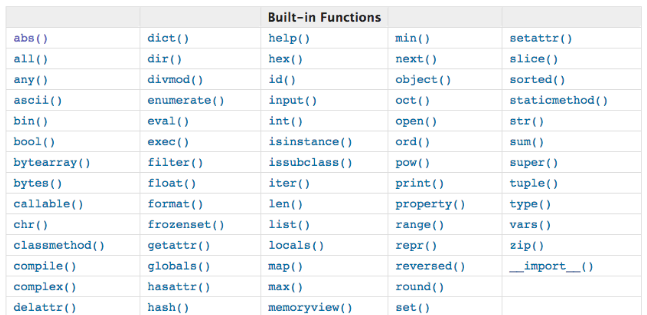内置函数表

abs() 绝对值
all() 判断
1 #一个为假,就为假 # 0 空 None Flase
2 print(all([1,'a',0]))#False
3 # 列表中所有元素的布尔值为真,最终结果才为真
4 print(all(''))
5 # 传给all的可迭代对象如果为空,最终结果为真
any() 判断
1 #但凡有一个为真,就为真
2 # print(any([0,'',None,1]))
3 print(any([]))
4 # 传给any的可迭代对象如果为空,最终结果为假
进制转换
1 print(bin(11)) #10-2
2 print(oct(11)) #10-8
3 print(hex(11)) #10-16
bool() 布尔值
1 print(bool(0))#0, None,空的布尔值为假
.encode() 转类型
1 res = '你好songhaiixng'.encode('utf-8')
2 print(res) #转成了bytes类型
3
4 res = bytes('你好songhaixing',encoding='utf-8')
5 print(res) #同上面一样
callable() 调用
1 def func():
2 pass
3 print(callable(func))
4 print(callable('ss'.strip))#判断
5 print(callable('dac'.split))#带括号的都可以调用
ASCLL表转化
1 print(chr(90))#按照表十进制转化成字符
2 print(ord('x'))#。。。。。。转化成数字
dir() 查看调用对象
1 print(dir('song'))#查看某个对象可以调用的方式
divmod() 除 余
1 print(divmod(10,3))#(3,1) 10除于3余1
2 print(divmod(10,2))#(5,0)
eval() 字符串内表达式 运算
1 #将字符内的表达式拿出来运行一下,并拿到改表达式的计算结果
2 res = eval('2**3') #(去掉字符串)
3 print(res)
4 res = eval('[1,2,3,4,]')
5 print(res)
1 with open('db.txt','r',encoding='utf-8')as f:
2 f = f.read() #{'name':'song','pwd':'123'}
3 res = eval(f) #把这个字典拿出来了
4 print(res,type(res))
5 print(res['pwd'])
frozenset() 不可变集合 冻结集合
1 fset = frozenset({1,2,3})
2
3 #可变
4 s = {1,2,3,4}
5 s.add(5)
6 print(s) #{1, 2, 3, 4, 5} 可变
globals() 全局作用域中的绑定关系
1 x = 1111111111111
2 print(globals())#查看全局作用域中名字于值得绑定关系
3 print(locals())
字典的key必须是不可变类型
不可hash的类型list,dict,set, == 可变的类型
可hash得类型int,float,str,tuple, == 不可变的类型
1 hash([1,2,3,4,5,6,])#不可hash
help() 显示帮助信息
1 def func():
2 """
3 帮助信息
4 :return:
5 """
6 pass
7 print(help(func)) #显示里面的帮助信息
8 print(help(max))
len() 长度
1 len({'x':1,'y':2})#调用 __len__
2 print({'x':1,'y':2}.__len__)
iter() 迭代器
1 res = iter('song')#'song'.__iter__
2 print(next(res))
pwo() 平方取余
1 print(pow(2,3,3))#2的3次方取余
slice() 切片
1 res = slice(1, 5, 2)#切片
2
3 l = [1, 2, 3, 4, 5, 6, 7, 8]
4 print(l[res]) #[2, 4]
5
6 t = (5, 14, 7, 8, 9, 5, 4, 2)
7 print(t[res]) #(14, 8)
sum() 求和
1 print(sum([1,2,3,4,5])) #15
vars()
zip() (拉链函数) 左右对应
1 left = 'hello'
2 # right = (1,2,3,) #[('h', 1), ('e', 2), ('l', 3)]
3 right = {'x':1,'e':2} #[('h', 'x'), ('e', 'e')]
4 res = zip(left,right)
5 print(list(res))



 浙公网安备 33010602011771号
浙公网安备 33010602011771号